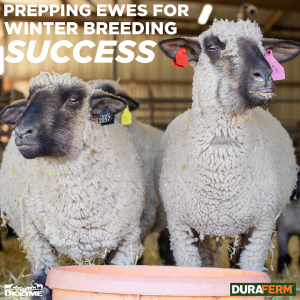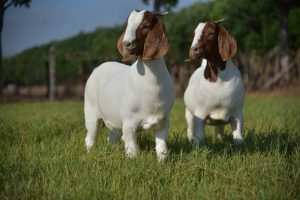
Goat AI
Artificial insemination (AI) is a technology that allows producers to propagate outstanding genetics at a faster rate. The does within the herd can be bred “artificially” with semen from an outstanding sire halfway across the country instead of using the genetics within one’s own herd.
With goats’ popularity growing and the demand for quality breeding and show stock on the rise, many producers are turning to goat AI to create the next “great animal.”
Although goat AI is not as prevalent as AI within other species like cattle and sheep, our BioZyme® team recently spoke with one person who specializes in reproductive technologies. Matt Kennedy, of Kennedy Livestock in Texas, performs goat AI on about 1,000 does annually. He shared his best practices and advice that he gives to his clients to ensure they experience conception rates.
Timing is Everything
When preparing for goat artificial insemination, or any breeding protocol, timing truly is everything. Goats come into heat or estrus approximately every 18 to 22 days. However, one of the primary benefits of AI is tightening your breeding and kidding window. This is the result of inducing estrus in your herd synchronizing them prior to AI.
Kennedy said he typically recommends a 17-day CIDR protocol when synching a group of does for breeding.
There are several protocols to follow. After talking to several breeders across the country, there is no one best synchronization program. Decide what works best for you and your system.
Protocol Example
Below is just one example of a synchronization and breeding protocol:
- Day 0: Insert CIDR & give Lutalyse injection.
- Day 15: Pull CIDRs and inject with PG 600.
- Day 16: Waiting day – check for signs of heat.
- Day 17: Breeding day. If signs of heat are present, AI is about the same time of day as when CIDRs were pulled and shots given.
- Day 18: If signs of heat were not present on the day prior, and your AI technician has left, you can try splash breeding or turn your doe out with the buck.
Remember, our team is not comprised of veterinarians nor are they reproductive experts. The DuraFerm Team is not saying the process outlined in this blog is the only—or even the best—way to perform goat AI. We’re just trying to showcase the methodology of the expert we consulted. The veterinarian you work with may have equally viable but different protocols they prefer. That’s why it’s so important to consult with them.
The goal of this blog is to help those with no idea what AI entails start this process with some idea of what to expect. As always, our goal with this content is to educate, not instruct. Always consult with your veterinarian or trusted goat AI technician. And also read and follow label directions on all medications.
Goat AI Day
Once you have synchronized your herd, you are ready for AI day. There are 2 common AI methods used for goats: cervical AI and laparoscopic AI.
Cervical AI
Cervical AI involves introducing semen into the cervix or just beyond it into the uterus. This method is typically performed through the doe’s vagina using a speculum to visualize the cervix.
Advantages of Cervical Goat AI
Cervical AI is less invasive than laparoscopic AI, reducing the stress and discomfort for the doe.
It generally requires less specialized equipment and fewer technical skills, making it more affordable and accessible.
Since it’s less invasive, does typically recover faster and can return to normal activities almost immediately.
Cervical AI requires basic training and equipment, making it easier for producers to learn and perform themselves.
Laparoscopic AI
Laparoscopic or surgical AI involves using a laparoscope to visualize the reproductive organs and directly deposit semen into the uterine horns. This method requires more specialized equipment and technical expertise.
Advantages of Laparoscopic Goat AI
Laparoscopic AI generally achieves higher conception rates because semen is deposited directly into the uterine horns, increasing the likelihood of fertilization.
The use of a laparoscope allows precise placement of semen, improving accuracy and reducing variability.
Laparoscopic AI is more effective with frozen-thawed semen, making it ideal for importing genetics or using preserved semen.
Utilization
Because of its higher success rates, laparoscopic AI is often used in larger breeding programs or when aiming to improve genetic lines rapidly.
Kennedy utilizes laparoscopic AI and injects semen into both sides of the uterine horn. He said he typically averages around a 70% conception rate when the does are in a good plane of nutrition and all protocols are followed.
Preparing the Does
Kennedy said that a quality nutrition program is the most important way to prepare for goat AI. Frankly, it will help you with any breeding protocol.
“Nutrition is the most important part of preparing for breeding,” he said. “Feeding a mineral like DuraFerm® Concept•Aid® will give the does the biggest advantage.”
DuraFerm® is a line of nutritional supplements for sheep and goats that supports optimal digestion and nutrition for maximized performance at every stage of production. DuraFerm offers two goat mineral options.
DuraFerm® Concept•Aid® Goat
DuraFerm Concept•Aid Goat is a free-choice vitamin and mineral supplement for goats designed to support reproductive success. The loose mineral comes in a 50-pound bag. DuraFerm Concept•Aid Goat contains AO-Biotics® Amaferm®, a prebiotic research proven to enhance digestibility.
It also includes high levels of vitamin E for reproductive tract repair. It supports embryo production and conception using organic trace minerals, including copper, zinc, manganese, and selenium.
DuraFerm® Concept•Aid® Protein Goat Tub
The DuraFerm Concept•Aid Protein Goat Tub is a protein tub with vitamins and minerals for goats designed to support reproductive success. The 50-pound tub also contains Amaferm to enhance digestibility. It contains the Concept•Aid goat mineral package in a 20% natural protein tub.
The DuraFerm Concept•Aid Protein Goat Tub supports embryo production and conception using organic trace minerals, including copper, zinc, manganese, and selenium.
Other Pre-breeding Considerations
In addition to providing a quality vitamin and mineral package in the DuraFerm Concept•Aid products, Kennedy also reminds producers to think about the overall nutrition of their herd.
As you go into breeding season, make sure to feed a diet lower in carbohydrates and high in fiber—but not legumes. High-quality native grass hay is preferred over alfalfa or another substitute forage.
Finally, Kennedy suggests letting your females be females. Don’t change up their routine just because they are getting bred. Don’t put them under any unnecessary stress, and don’t change their routine.
The Benefits of Goat AI
We have given you some basic advice on preparing your does for artificial insemination and offered a sample protocol. But, for everything you do within your operation, you need to weigh the benefits against the challenges.
Here are 5 benefits of goat AI:
1. Genetic Improvement
AI allows producers access to high-quality genetics from top sires, even if the sires are located far away. This can help improve traits like milk production, meat quality, fertility, and disease resistance in the herd.
2. Diverse Genetic Pool
By using AI, producers can introduce new bloodlines into their herd without needing to purchase or maintain multiple bucks. This diversity helps reduce inbreeding, which can lead to genetic defects and reduced fertility.
3. Reduced Disease Transmission
AI reduces the risk of sexually transmitted diseases that can occur with natural mating. Since semen can be screened and processed to ensure it’s free of pathogens, AI promotes herd health and biosecurity.
4. Controlled Breeding & Timing
AI allows for precise control over breeding seasons, enabling producers to synchronize kidding times, manage the number of offspring, and align production with market demands. This control is especially useful in intensive production systems where timing is critical.
5. Improved Recordkeeping
AI provides detailed information about the genetics and pedigree of the offspring, facilitating better recordkeeping and management. This can help with breeding decisions, lineage tracking, and pedigree verification.
While AI offers many benefits, it’s important to consider the technical requirements and expertise needed for successful implementation. Proper training, equipment, and semen storage facilities are crucial for achieving high success rates with goat AI. Additionally, factors like timing of insemination, doe health, and estrus detection play a significant role in AI success.
Goat AI Offers Challenges
Artificial insemination in goats offers many benefits, but it also comes with several challenges that need to be addressed to ensure successful outcomes.
Let’s explore some of the key challenges & considerations associated with goat AI:
1. Technical Expertise
Successful AI in goats requires specialized knowledge and skills. Proper training is essential for handling semen, performing insemination, and managing equipment. Lack of expertise can lead to low conception rates and poor handling practices.
Most goat AI is performed by a veterinarian or a trained reproductive expert. We recommend you consult with one or both of these types of professionals when considering AI for your animals.
2. Estrus Detection & Synchronization
Identifying the right time for insemination is crucial for success. Goats have a relatively short estrus period (heat), and accurate detection is critical. Missed or inaccurate detection can result in failed insemination attempts.
To maximize efficiency, many goat AI programs use estrus synchronization to breed multiple does at once. This process involves hormonal treatments, which require careful management and understanding of reproductive cycles.
3. Semen Quality & Handling
The quality of semen used in AI is a significant factor in success rates. Proper collection, processing, and storage are essential to maintain semen viability. Mishandling can reduce sperm motility and viability, leading to lower conception rates.
4. Infrastructure & Equipment
AI requires specialized equipment for semen storage, such as liquid nitrogen tanks, as well as tools for insemination. Acquiring and maintaining this equipment can be costly, and improper storage can affect semen quality.
5. Conception Rates
Conception rates with AI can vary based on several factors, including the skill of the technician, semen quality, timing of insemination and the health and condition of the doe. Lower success rates compared to natural breeding can be a challenge.
6. Cost & Investment
AI can involve significant upfront costs for equipment, training, and infrastructure. While it can be cost-effective in the long run, the initial investment might be prohibitive for smaller operations.
Overcoming these challenges requires careful planning, training, and investment in proper infrastructure and procedures.
Let DuraFerm Help Strengthen Your Stock
As we mentioned, we are not reproductive experts. However, as Kennedy pointed out, good reproduction starts with a quality nutrition program like DuraFerm. At DuraFerm we value care that comes full circle.
That means we want to provide you with a great mineral for your herd as well as some timely educational information. Remember, we are just one resource, and we want you to work closely with your veterinarian and reproductive expert.
Get your DuraFerm Today
If you are ready to invest in a nutrition program like DuraFerm, today is a great day for that. You can purchase DuraFerm products powered by AO-Biotics Amaferm. DuraFerm is available through the extensive BioZyme dealer network. Locate a dealer near you today. DuraFerm offers reproduction resilience and retention. What more could you ask for?
Don’t forget to use our Goat Gestation Calculator. This handy guide will help you with all your goat breeding calculations.
You can also gather more information about DuraFerm from our educational blog series or by signing up for our newsletter.

